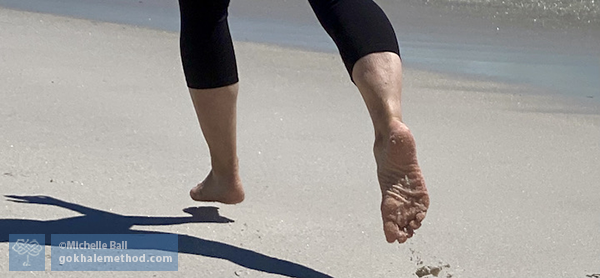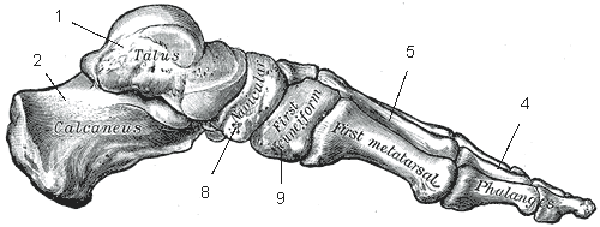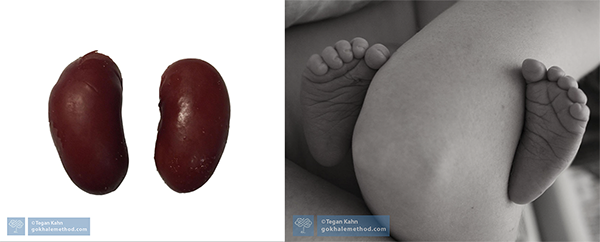Gliderunning: Part 2: Meet Your Feet
Welcome to the second blog post in our series on running. My name is Michelle Ball, and I am a Gokhale Method™ teacher in Tasmania. I am a life-long runner, and am passionate about sharing my experience with beginners and would-be beginners, as well as seasoned runners and everyone in between. If you missed Part 1, you can catch up here.
Reactivate your feet
When it comes to advice about running, the feet often get overlooked as the subject immediately turns to shoes. While shoes are an important subject (spoiler alert! Part 3 is about shoes), I prefer to start with that miracle of bioengineering that actually does the work—your feet.
Our feet become very passive from walking on flat, featureless surfaces rather than natural, more undulating terrain. They are also constrained, misshapen and deconditioned by less-than-ideal footwear, which, sadly, includes many running shoes on the market.

Running on sand trains my feet to grab the ground and push it behind me.
Learning to engage and strengthen my feet has been a game changer, enabling me to recover from old running injuries and enjoy running into my sixth decade. I would therefore like to share some well chosen exercises you can do in addition to training on the job. These will both strengthen your feet and train them in better patterns of muscle recruitment. Your feet will soon engage more actively than they are likely used to doing.

Some basic anatomical knowledge can help us get to know and appreciate our feet. This beautiful 1850s engraving (by Henry Vandyke Carter, Gray’s Anatomy) illustrates the primary arch that gives the foot its convexity. Wikimedia
Exercise 1: Inching your way to stronger feet
Inchworm is an excellent warm-up exercise, mobilizing the toe joints, mid foot, and heel bone, contracting and releasing the plantar muscles, and lifting the inner arches and also the transverse arch which spans the base of the toes. It mimics the grabbing action our feet naturally make when accustomed to walking on more varied surfaces.
This video shows how my plantar muscles contract and release to inch my foot forward. I alternately release my heel, and then my toes, from the ground.
Exercise 2: Kidney-bean shaping the feet.
One of my favorite Gokhale Method® concepts to help develop strong, functional feet, is “kidney-bean shaping.” Like inchworm, it strengthens the four layers of plantar muscle, helps raise the inner arches, and also preserves the transverse arch which spans the base of the toes. Restoring tone in these areas confers the springiness you are looking for and protects against common foot problems such as plantar fasciitis, Morton’s neuroma, and bunions. Infant’s feet have this more bean-like shape, and this is the shape preserved into adulthood among more traditional, nonindustrialized societies around the world.

Infants’ feet have a notably bean-like shape.

In nonindustrial societies a bean-shaped foot is maintained throughout life.
In addition, kidney-bean shaping the foot enables us to find a healthy outward angle for the feet and legs, and weight in our heels when standing. This multipurpose exercise is taught in all three formats for learning the Gokhale Method—our in-person Foundations course, our online Elements course, and our Pop-up course. Directions can also be found in Esther Gokhale’s number one best-selling book, 8 Steps to a Pain-Free Back, and her DVD (streamable), Back Pain: The Primal Posture™ Solution.

These photos show how, if you have a tendency toward flat feet (left), kidney-bean shaping can restore your arches, and counter any tendency to being pigeon-toed (right). It also guides your big toe home, reducing bunions. Modeled by Tegan Kahn, our Gokhale Method teacher in Australia.
Exercise 3: Bob before you jog
If you are not in the habit of jogging, or even if you do so already, it is good to ensure you jog with spring in your feet. This contributes to both push off and, most importantly for injury prevention, absorbs energy on impact. This is a natural, effective, and sophisticated mechanism that uses your muscles and foot structure rather than relying on heavily padded shoes to cushion your landing. It helps care for and protect all the weight-bearing joints in the body, as well as your feet.
CAUTION: If you have back pain or reason to believe you may have spinal degeneration, we recommend you take one of our courses to learn appropriate techniques to protect your spine before doing this exercise.
Getting started with bobbing
I recommend you start bobbing by shifting from one foot to the other with the heels scarcely leaving the ground. Initially just a few minutes may be plenty, and you can develop resilience for greater bounce and duration over a number of weeks. I like to suggest students play music and make it a dance. A few tracks each day will quickly build strength in your feet.
Esther demonstrates bobbing on the feet. These clips are from her 1-2-3 Move program for Alumni. Each 15-minute Dance Party has bobbing covered!
Bobbing is a very adaptable exercise for all levels of foot strength—from slowly shifting your weight from one foot to the other, to your first split second of being airborne. As you get stronger you can intensify the work with more skipping and even hopping.
6-Part Gliderunning Series
- Read Part 1: Introduction.
- Read Part 2: Meet Your Feet.
- Read Part 3: How to Choose Running Shoes.
- Read Part 4: Taking Care of Your Knees.
- Read Part 5: Anteverted Pelvis.
- Read Part 6: Upper Body.
Free Online Workshops
If you would like to find out more about how the Gokhale Method can help support you, whether you are currently sedentary or a seasoned runner, sign up to join one of Esther’s upcoming FREE Online Workshops.

Comments
Thanks for sharing these tips
Thanks for sharing these tips. I watched the bobbying video. It looks like more of the weight is on the front of the feet during the bobbing. Is that right? I think I remember from the class that the weight in standing should be more on the heals. How do these things relate? The standing and the bobbing? Thank You!
You're correct, Stacy! In
You're correct, Stacy! In standing most of your weight wants to be on your heels; in bobbing (and sprinting and lots of other actions) your weight transfers to the forefoot.
Add New Comment
Login to add commment
Login